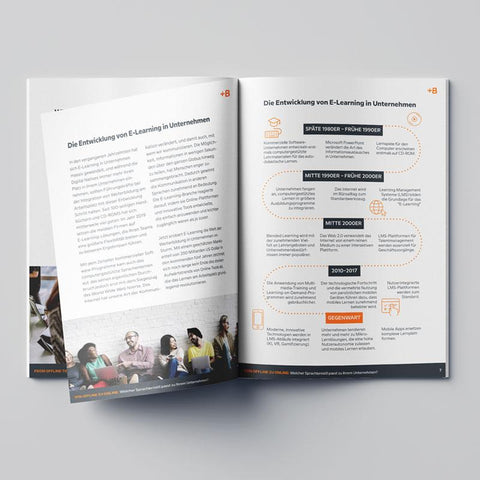E-learning with online seminars and training sessions has now become indispensable for companies. It’s not just large enterprises that have turned to digital learning — more and more small and medium-sized companies are doing so as well. According to a survey by the German Economic Institute, already in 2014 around one-fourth of small and medium-sized companies and half of large enterprises had introduced e-learning for employee qualification. It can be expected that the importance of digital learning for professional training will only increase further in the time of corona. E-learning isn’t bound to a specific place or personal contact. And the pandemic is driving digitalization in many companies. This is where e-learning contributes to helping employees openly face the challenges of digitalization and orient themselves around digitalization at work.
What is e-learning?
E-learning stands for “electronic learning” or gaining knowledge through digital media. Team members can decide themselves when, where, and how quickly they want to learn, which allows digital learning to be easily integrated into daily work routines. When it’s combined with lessons led by a teacher, then it’s known as blended learning.
All e-learning technologies use multimedia learning content that can be accessed on the computer or mobile devices. These options are used most frequently:
- Web-based training
With web-based training, learners have access to digital content that they can use independently anywhere and anytime. Exchanging with teachers, tutors, or coaches as well as with other learners generally takes place in written form by email or chat.
- Webinars
Webinars are interactive online seminars. The knowledge transfer and exchanges between participants takes place live. Webinars are scheduled at a specific time and are usually accessed via a browser with web-based applications like Google Meet.
- Virtual classrooms
Virtual classrooms follow the same principle as webinars, but there are more possibilities for learners and teachers. For example, there can be audio and video conferences, interactive whiteboards, and chats for individual exchanges in small groups.
- Learning videos
Videos have long been an important medium for digital learning. They’re offered online on numerous topics and questions. Large enterprises in particular produce their own videos for employee training. The videos can convey instructions, information, or background knowledge. They’re limited, however, in how the knowledge transfer can be verified or made interactive.
- Podcasts
Podcasts are audio or video episodes that are released regularly. In a company, they’re relevant especially to convey current tips and information.
- Learning apps
Learning apps are digital tools used on mobile devices. Learning apps can be used for many diverse topics. For example, the Babbel app makes it possible to learn a new language flexibly and efficiently. Learning apps have established a new trend in e-learning in recent years that companies have used to transfer knowledge in a fun way. When participants compare themselves with each other through a quiz or digital competition, it doesn’t just promote learning, but also a sense of fun and togetherness, which strengthens motivation.

Why e-learning continues to grow in significance
In the coronavirus crisis, the advantages of e-learning have become all the more apparent. Social distancing and restrictions on personal contact don’t affect digital learning, meaning companies don’t have to postpone their training programs until the pandemic is over. Digital learning tools can be used without issue when working from home, and interactive learning in groups is also possible thanks to video calls and chat rooms. In addition, e-learning can help transfer urgent information efficiently.
This is how e-learning can meet the requirements of companies and employees:
- Individual learning solutions for companies
With e-learning, companies can combine different learning components like building blocks and develop individual or group learning programs. Conventional seminars, on the other hand, can only offer standard approaches.
- Personalized learning
E-learning keeps employees from having to sit through irrelevant training sessions. The digital learning contents can be designed in a way that corresponds to the learner’s individual knowledge level. That helps increase learner motivation to gain new knowledge and use it in their day-to-day work.
- Transparent learning progress
When companies actively monitor and analyze their digital learning solutions, they understand how their employees learn, where they’re making progress, and where there are obstacles. This makes it possible to adjust the learning contents to the learners’ requirements. For example, certain lessons can be repeated, content already learned can be skipped, or additional information can be used to deepen what’s been learned. With self-assessments and virtual group exchanges, employees can continually monitor their own learning progress.
- Efficiency and possibilities for optimization
Digital learning is inexpensive. No substantial investments are needed, travel expenses are unnecessary, and work interruptions don’t play a role. The funds saved can instead be invested in high-quality learning content and improving the e-learning program.

Why you should use e-learning for training in your company
E-learning has changed enormously in the past 20 years. Companies and their employees have access to a wide variety of digital learning tools and can benefit from tailored, flexible, and highly personalized digital learning solutions. With e-learning, companies are able to increase the quality of their training offerings — usually for a fraction of the cost of in-person training. E-learning also contributes to establishing a culture of life-long learning in a company and strengthening team cohesion and motivation.

Read more about digitalization and language learning in companies! Our practical guide introduces you to the different possibilities for learning languages offline and online.





